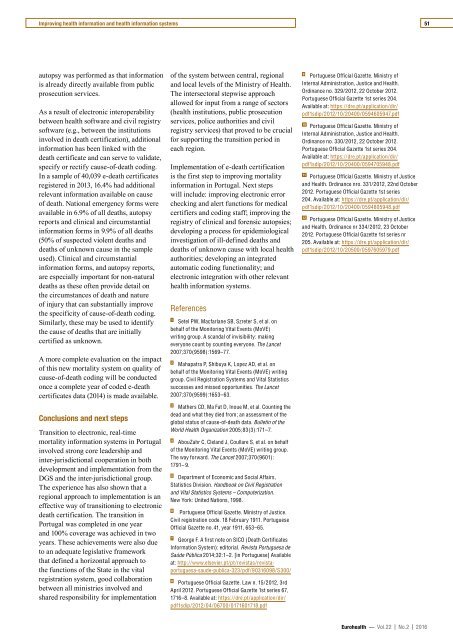EUROHEALTH
Eurohealth-volume22-number2-2016
Eurohealth-volume22-number2-2016
Create successful ePaper yourself
Turn your PDF publications into a flip-book with our unique Google optimized e-Paper software.
Improving health information and health information systems<br />
51<br />
autopsy was performed as that information<br />
is already directly available from public<br />
prosecution services.<br />
As a result of electronic interoperability<br />
between health software and civil registry<br />
software (e.g., between the institutions<br />
involved in death certification), additional<br />
information has been linked with the<br />
death certificate and can serve to validate,<br />
specify or rectify cause-of-death coding.<br />
In a sample of 40,039 e-death certificates<br />
registered in 2013, 16.4% had additional<br />
relevant information available on cause<br />
of death. National emergency forms were<br />
available in 6.9% of all deaths, autopsy<br />
reports and clinical and circumstantial<br />
information forms in 9.9% of all deaths<br />
(50% of suspected violent deaths and<br />
deaths of unknown cause in the sample<br />
used). Clinical and circumstantial<br />
information forms, and autopsy reports,<br />
are especially important for non-natural<br />
deaths as these often provide detail on<br />
the circumstances of death and nature<br />
of injury that can substantially improve<br />
the specificity of cause-of-death coding.<br />
Similarly, these may be used to identify<br />
the cause of deaths that are initially<br />
certified as unknown.<br />
A more complete evaluation on the impact<br />
of this new mortality system on quality of<br />
cause-of-death coding will be conducted<br />
once a complete year of coded e-death<br />
certificates data (2014) is made available.<br />
Conclusions and next steps<br />
Transition to electronic, real-time<br />
mortality information systems in Portugal<br />
involved strong core leadership and<br />
inter-jurisdictional cooperation in both<br />
development and implementation from the<br />
DGS and the inter-jurisdictional group.<br />
The experience has also shown that a<br />
regional approach to implementation is an<br />
effective way of transitioning to electronic<br />
death certification. The transition in<br />
Portugal was completed in one year<br />
and 100% coverage was achieved in two<br />
years. These achievements were also due<br />
to an adequate legislative framework<br />
that defined a horizontal approach to<br />
the functions of the State in the vital<br />
registration system, good collaboration<br />
between all ministries involved and<br />
shared responsibility for implementation<br />
of the system between central, regional<br />
and local levels of the Ministry of Health.<br />
The intersectoral stepwise approach<br />
allowed for input from a range of sectors<br />
(health institutions, public prosecution<br />
services, police authorities and civil<br />
registry services) that proved to be crucial<br />
for supporting the transition period in<br />
each region.<br />
Implementation of e-death certification<br />
is the first step to improving mortality<br />
information in Portugal. Next steps<br />
will include: improving electronic error<br />
checking and alert functions for medical<br />
certifiers and coding staff; improving the<br />
registry of clinical and forensic autopsies;<br />
developing a process for epidemiological<br />
investigation of ill-defined deaths and<br />
deaths of unknown cause with local health<br />
authorities; developing an integrated<br />
automatic coding functionality; and<br />
electronic integration with other relevant<br />
health information systems.<br />
References<br />
1<br />
Setel PW, Macfarlane SB, Szreter S, et al. on<br />
behalf of the Monitoring Vital Events (MoVE)<br />
writing group. A scandal of invisibility: making<br />
everyone count by counting everyone. The Lancet<br />
2007;370(9598):1569 – 77.<br />
2<br />
Mahapatra P, Shibuya K, Lopez AD, et al. on<br />
behalf of the Monitoring Vital Events (MoVE) writing<br />
group. Civil Registration Systems and Vital Statistics<br />
successes and missed opportunities. The Lancet<br />
2007;370(9599):1653 – 63.<br />
3<br />
Mathers CD, Ma Fat D, Inoue M, et al. Counting the<br />
dead and what they died from; an assessment of the<br />
global status of cause-of-death data. Bulletin of the<br />
World Health Organization 2005;83(3):171 – 7.<br />
4<br />
AbouZahr C, Cleland J, Coullare S, et al. on behalf<br />
of the Monitoring Vital Events (MoVE) writing group.<br />
The way forward. The Lancet 2007;370(9601):<br />
1791 – 9.<br />
5<br />
Department of Economic and Social Affairs,<br />
Statistics Division. Handbook on Civil Registration<br />
and Vital Statistics Systems – Computerization.<br />
New York: United Nations, 1998.<br />
6<br />
Portuguese Official Gazette. Ministry of Justice.<br />
Civil registration code. 18 February 1911. Portuguese<br />
Official Gazette no. 41, year 1911, 653 – 65.<br />
7<br />
George F. A first note on SICO (Death Certificates<br />
Information System): editorial. Revista Portuguesa de<br />
Saúde Pública 2014;32:1 – 2. [in Portuguese] Available<br />
at: http://www.elsevier.pt/pt/revistas/revistaportuguesa-saude-publica-323/pdf/90316098/S300/<br />
8<br />
Portuguese Official Gazette. Law n. 15/2012, 3rd<br />
April 2012. Portuguese Official Gazette 1st series 67,<br />
1716 – 8. Available at: https://dre.pt/application/dir/<br />
pdf1sdip/2012/04/06700/0171601718.pdf<br />
9<br />
Portuguese Official Gazette. Ministry of<br />
Internal Administration, Justice and Health.<br />
Ordinance no. 329/2012, 22 October 2012.<br />
Portuguese Official Gazette 1st series 204.<br />
Available at: https://dre.pt/application/dir/<br />
pdf1sdip/2012/10/20400/0594605947.pdf<br />
10<br />
Portuguese Official Gazette. Ministry of<br />
Internal Administration, Justice and Health.<br />
Ordinance no. 330/2012, 22 October 2012.<br />
Portuguese Official Gazette 1st series 204.<br />
Available at: https://dre.pt/application/dir/<br />
pdf1sdip/2012/10/20400/0594705948.pdf<br />
11<br />
Portuguese Official Gazette. Ministry of Justice<br />
and Health. Ordinance nro. 331/2012, 22nd October<br />
2012. Portuguese Official Gazette 1st series<br />
204. Available at: https://dre.pt/application/dir/<br />
pdf1sdip/2012/10/20400/0594805948.pdf<br />
12<br />
Portuguese Official Gazette. Ministry of Justice<br />
and Health. Ordinance nr 334/2012, 23 October<br />
2012. Portuguese Official Gazette 1st series nr<br />
205. Available at: https://dre.pt/application/dir/<br />
pdf1sdip/2012/10/20500/0597605979.pdf<br />
Eurohealth — Vol.22 | No.2 | 2016
















